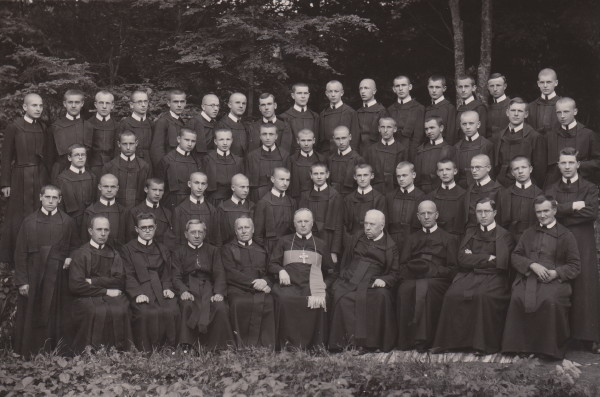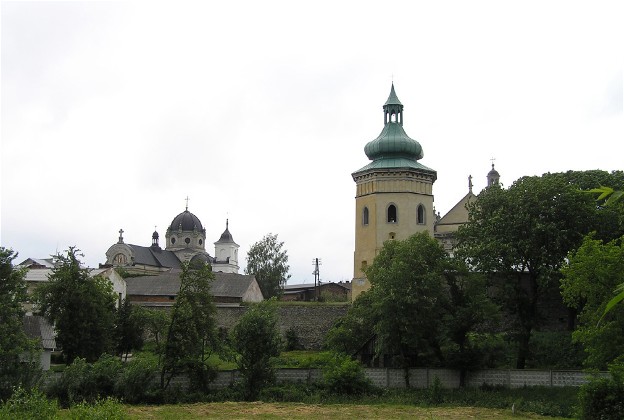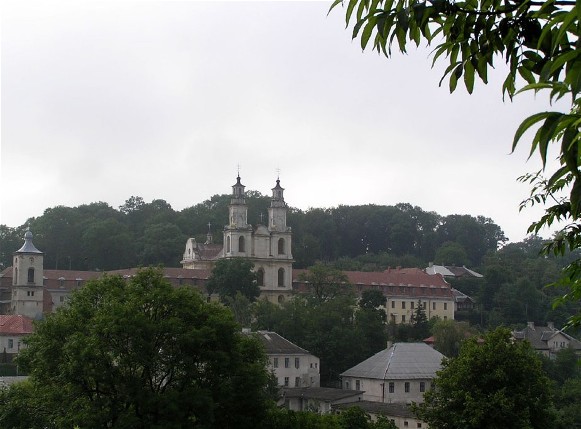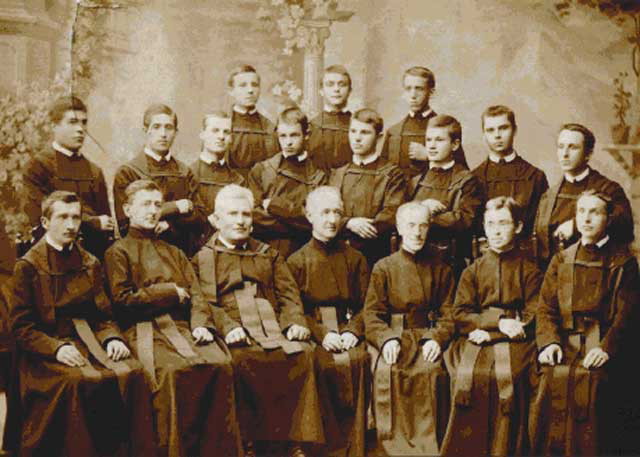Basilian monastic order
Basilian monastic order [Чин святого Василія Великого; Chyn sviatoho Vasyliia Velykoho]. A monastic order established by Saint Basil the Great and governed by his rule, which was codified in approximately 362 AD and consisted of 55 ‘longer’ rules and 313 ‘shorter’ rules. These rules became the foundation of organized monastic life in the Eastern church and partly in the Western church. Saint Basil’s rules, with some later additions (such as the Constitution of Saint Theodore Studite), were put into practice mainly in the Byzantine Empire and from there were introduced into Ukraine along with monasticism in the 11th century. The Basilian monasteries were not organized into a single system but were subordinated to local bishops or, in some exceptional cases (ie, Stauropegion monasteries), directly to the patriarch of Constantinople.
After the Church Union of Berestia (1596) the metropolitan of Kyiv, Yosyf Rutsky, with the assistance of Archbishop Yosafat Kuntsevych, organized the monasteries in the Ukrainian-Belarusian eparchies that had adopted the union with Rome into one Congregation of the Holy Trinity under a common leadership and prescribed a rule for them. He made the Basilian monasteries independent of the bishops and subject to the protoarchimandrite. The monasteries were governed by hegumens, who were appointed for four years, and by archimandrites, who by this time were nominated by the king or other patrons and were appointed by the metropolitan. The appointments were for life and conferred special privileges and insignia. General assemblies were to be called every four years. The monastic code was modeled on the codes of Western orders. In 1624 the new rule of the Basilian order was confirmed by the Congregation for the Propagation of the Faith and, in 1631, by Pope Urban VIII. The order became in part directly subordinate to the metropolitan and the pope. Until 1675 the metropolitans were protoarchimandrites for life. Afterwards, monks were appointed protoarchimandrites for four years. The Basilian novitiate was in Vilnius, then in Byten, Volhynia; philosophical studies were taken in Zhyrovichy, Belarus, and theological studies in Western Europe, where the Basilians had 22 scholarships at papal colleges. In the 17th century the congregation was centered in Belarus (because the Galician eparchies adopted the union only later, in about 1700), and it was an effective agent of the union. By a papal decree of 1635 the Catholic bishops of the Eastern rite had to be Basilians.
The Basilians were active in missionary work, education, and publishing. (They had a special missionary method, and missionaries had special privileges.) They devoted much energy to the teaching of Church Slavonic, especially to students of Polish colleges in order to keep them in the Eastern rite. In 1615 Metropolitan Rutsky got permission from Pope Paul V to establish schools, and almost every monastery had a Basilian school. In 1626 the Synod of Kobryn put the Basilians in charge of the eparchial seminary in Minsk.
The 18th century was the most active period of the order. In 1720 the Synod of Zamostia ordered all Catholic monasteries that were governed by the old Eastern rule to join the Basilian order. As a result, in 1739 a new Congregation of the Protection of the Mother of God, also called the Ruthenian congregation, was created in Lviv and took its place beside the Congregation of the Holy Trinity, known also as the Lithuanian congregation. In 1743, by the order of Pope Benedict XIV, the two congregations merged into one Basilian order at the assembly of the hierarchy and monastic representatives at Dubno. From that time all the monks in the Lithuanian province (mostly Belarusian territories within the Grand Duchy of Lithuania) and the Ruthenian province (Ukrainian territories within the Polish Kingdom) were subordinated to the Basilian protoarchimandrite. In 1780 at the general assembly in Tarakaniv, Volhynia, the Basilian order was divided into four provinces: Lithuanian, Belarusian, Crown (or Ruthenian), and Galician. The order then had 155 monasteries and 1,235 monks, of whom 950 were priests. The protoarchimandrite was chosen in turn from each province for four and then for eight years. The provinces were governed by protohegumens, the larger monasteries by archimandrites appointed for life, and the smaller ones by hegumens appointed for four years.
The Basilians were especially active in education and publishing at this time. They were in charge of colleges for young men in Uman, Hoshcha, Liubar, Sharhorod, Buchach, and Volodymyr-Volynskyi (the most famous one), and schools for the sons of the impoverished gentry. The Basilians took over Jesuit schools, among them the famous Ostroh Academy.
The main publishing center was Pochaiv in Volhynia, then Suprasl in Belarus and Univ near Lviv. In 1733–1800 the Pochaiv Monastery Press produced (besides Latin and Polish books) over 100 publications, including liturgical books, sermons, and Bohohlasnyk (a religious songbook) in 1791. The Basilians also built churches, such as those in Pochaiv and Zhyrovichy and Saint George's Cathedral in Lviv.
After the partitions of Poland, when all the Basilian provinces except Galicia became part of the Russian Empire, the Basilian order began to suffer persecution. Catherine II reduced the hierarchy and subordinated the Basilian monasteries to the archbishop of Polatsk. Relations with church authorities outside Russia were forbidden. After some improvements under Paul I, Alexander I abolished the office of protoarchimandrite in 1804, and Nicholas I abolished the offices of protohegumens, subordinating them to the eparchial consistory in 1832. In 1839, after the abolition of the Uniate church in Ukraine and Belarus, the Basilian monasteries were finally closed down. Some of the monks were exiled; others were imprisoned in monasteries. Five Basilian monasteries remained in the Kholm region, but in 1864 the Russian authorities closed down four of them and soon afterwards closed down the last one in Warsaw.
The Basilian monastic order survived only in the Galician Province of the Holy Savior, which was under Austrian rule. During Maria Theresa’s reign the province developed well, but Joseph II closed down all the monasteries that did not provide social services and subordinated the rest to local bishops. He almost eliminated the vow of poverty. These actions led to the decline of the monasteries: of the 50 monasteries and 329 monks in Galicia in 1772–3, scarcely 15 monasteries and 40 monks remained. Then, in 1882, Pope Leo XIII consented to entrust the reform of the Basilian order to the Jesuits. This gave the order new life. In 1904 the first protohegumen was elected—Rev Platonid Petro Filias. In 1931, when the order had several provinces (Galician, Transcarpathian, American-Canadian, and the Brazilian vice-province), Rev Dionysii Dmytro Tkachuk was elected as its first archimandrite. He was succeeded by Rev Tyt Teodosii Halushchynsky, Rev P. Myskiv, Rev Atanasii Velyky, and Rev Isydor Patrylo (the last three with the title of protoarchimandrite). All of them, with their advisers, resided in Rome.
After the reform, the Basilian order renewed its missionary work only among Ukrainians. The following were prominently involved in this work: Rev Andrei Sheptytsky (later metropolitan), Platonid Petro Filias, Soter Ortynsky, M. Lonchyna, I. Tysovsky, L. Manko, Y. Chepil, Y. Luchynsky, Ya. Senkivsky, and V. Bairak. The Basilians had an influence on young people through the Marian societies (with over 20,000 members). After 1918 the Basilians ran a seminary in Lviv (to 1926; see Greek Catholic Theological Seminary in Lviv) and Zagreb (1924–55), lectured at the theological seminaries in Peremyshl (see Peremyshl Greek Catholic Theological Seminary) and Stanyslaviv, and ran a junior gymnasium and student residence in Buchach. They are still in charge of the Saint Josaphat's Ukrainian Pontifical College in Rome. Zhovkva (see Zhovkva Monastery) was their publishing center in Galicia. There they published the monthly Misionar, Nash pryiatel’ for young people, and the scholarly journal Zapysky Chyna sv. Vasyliia Velykoho (Analecta Ordinis S. Basilii Magni/Zapysky ChSVV). The scholarly works of Rev Tyt Teodosii Halushchynsky, Yosafat Skruten, Dionisii Holovetsky, R. Lukan, Teofil Kostruba, Atanasii Velyky, Meletius Wojnar, Meletii Solovii, and others won recognition.
The Basilians of Galicia became active in Transcarpathia in 1921 by reforming monasteries there that previously had had no relation with the Basilians. The following priests worked in Transcarpathia: Ye. Malytsky, P. Bulyk, Hlib Kinakh, Stepan Reshetylo, and the poet Zoreslav—Rev Sevastiian-Stepan Sabol. The Basilians published the periodicals Blahovisnyk and Misionar in Uzhhorod and opened a gymnasium in Uzhhorod and a novitiate in Mukachevo. This work contributed to the awakening of national consciousness in Transcarpathia. Rev L. Dolhy and others expanded their activities into the monasteries of Hungary, with the center in Máriapócs, while Rev A. Maksym worked in Romania, where the Basilians established missions and their own printing press.
At the end of the 19th century the Basilians began to minister to the needs of Ukrainian immigrants overseas. Their services were critical in light of the generally hostile reception afforded married Ukrainian clergymen by Roman Catholic hierarchs in the New World. In 1897 the first Basilians arrived in Brazil (S. Kizyma and A. Martyniuk). Besides ministering to the Ukrainian colonies in Brazil, the Basilians, whose headquarters were in Prudentópolis, ran a boarding school, novitiate, and courses for monks, and published Ukraïns'kyï misionar and the weekly Pratsia (Brazil). In 1932 the Brazilian subprovince was established, and in 1948 it became a province. In 1934 the Basilians expanded from Brazil into Argentina. In 1948 Argentina became a subprovince with a boarding school, novitiate, and occasional courses. The monthly Zhyttia (Argentina) is published there. The first Ukrainian Catholic bishop in Brazil, Yosyp Martynets (1958–78), and his successor, Yefrem Kryvy, were members of the order.
In 1902 Revs Platonid Petro Filias, S. Dydyk, and A. Strotsky began their work in Canada, settling in Alberta near present-day Mundare. While ministering to the faithful, the Basilians there still run a novitiate and monasteries. They have established their own publishing house in Toronto and publish the journal Svitlo. Several bishops in Canada were and are Basilians: Vasyl Ladyka (1929, Winnipeg, later archbishop), Nil Savaryn (1943, Edmonton), Isidore Chimy (1974, New Westminster), Myron Daciuk (1983–91, auxiliary bishop of Winnipeg; 1991–6, bishop of Edmonton), Severian Yakymyshyn (bishop of New Westminster since 1995), Cornelius Pasichny (1996–8, bishop of Saskatoon; 1998–2002, bishop of Toronto), and Lawrence Huculak (bishop of Edmonton since 1997). In the United States the Basilians centered their work in New York, Chicago, and Detroit parishes. The first bishop of the Ukrainians in the United States was the Basilian Soter Ortynsky (1907). Since 1926 Revs Yepifan Teodorovych, S. Zhuravetsky, Hryhorii Andrii Trukh, and later Ambrose Senyshyn (from 1942 as auxiliary bishop and 1961 as metropolitan) have worked there. In 1932 the American-Canadian province was established, and in 1948 it was divided into two provinces. The Basilians in the United States have a novitiate in Glen Cove, New York State. The bishop responsible for the Ukrainian Catholics in England in 1961–87, Avhustyn Horniak, was also a Basilian, as is the present apostolic exarch, Paul Chomnycky.
Before the Second World War the Basilian order had three provinces: the Galician (378 monks), the Transcarpathian (163 monks, of whom 100 were in Transcarpathia, 20 in Hungary, and 43 in Romania), and the American-Canadian (93 monks). With the 24 monks in the Brazilian subprovince, this made a total of 658 monks.
After the abolition of the Ukrainian Catholic church by Soviet authorities in 1946, 250 Basilian monks worked freely only in the Americas, where there were three provinces—the Canadian, American, and Brazilian—as well as the Argentinian subprovince. There was also a province in Poland.
Following Ukrainian independence in 1991, the order began operating once again in Ukraine. By 2000 it had developed a network of over 20 monasteries and mission stations as well as a novitiate in Krekhiv. These included returned historic properties such as the Saint Onuphrius's Church and Monastery (Lviv), the Krekhiv Monastery, the Zhovkva Monastery, and the Hoshiv Monastery as well as the newly constructed Saint Basil the Great Monastery in Kyiv. The order now also has a monastery in Vilnius. The Basilians resumed their publishing activity in Ukraine even before their Zhovkva press facilities were returned to the order in 1994, reviving the religious journal Misionar and producing a variety of other publications.
(See also Basilian order of nuns.)
BIBLIOGRAPHY
Kulczyński, J. Menologium Bazyliańskie (Vilnius 1771)
Koialovich, M. ‘Istoriia Bazilianskogo Ordena,’ Khristianskoe chtenie, 1–4 (Saint Petersburg 1864)
Kossak, M. Shematizm Provintsii sv. Spasitelia China Sv. Vasiliia V. v Halitsii i korotkii pohliad na monastyri i na monashestvo ruske, ot zavedenia na Rusi viry Khristovoi azh po ninishnoe vremia (Lviv 1867)
Petrov, N. ‘Ocherk istorii Bazilianskogo Ordena v byvshei Pol'she,’ TDKA, 1870, nos 5, 8, 11; 1871, nos 2, 5, 6, 7; 1872, nos 1, 2
Iwanowicz, I. Über die historische Bedeutung des Basilianerordens in Galizien (Leipzig 1885)
Savaryn, N. Rolia otsiv Vasyliian u Kanadi (Mundare 1938)
Wojnar, M. ‘De Regimine Basilianorum Ruthenorum,’ AOBM, 2 (1949), no. 1
Voinar, M. ‘Vasyliiany v ukraïns'kim narodi,’ Slovo dobroho pastyria, 1, nos 7–8 (1950)
Propam’iatna knyha oo. Vasyliian u Kanadi (Toronto 1953)
Vavryk, M. Narys rozvytku i stanu Vasyliians'koho Chyna XVII–XX st.: Topohrafichno-statystychna rozvidka z kartoiu monastyriv (Rome 1979)
Pidlypczak,-Majerowicz, M. Bazylianie w Koronie i na Litwie: Szkoły i książki w dzialalności zakonu (Warsaw 1986)
Narys istoriï Vasyliians’koho chynu Sviatoho Iosofata. Vol 48 of ZChSVV, Series II, Section I (Pratsi) (Rome 1992)
Irynei Nazarko
[This article was updated in 2000.]

%20with%20Andrei%20Sheptytsky.jpg)



%20Basilian%20church.jpg)
